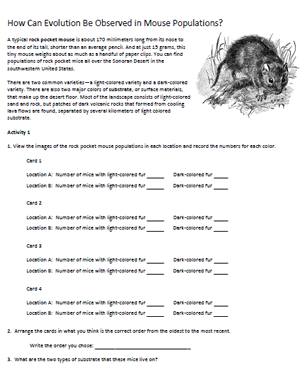
This worksheet was modified from the HHMI Activity on color variation in the rock pocket mouse. It has been simplified from the original activity so that it is suitable for beginner biology students.
Students look at cards showing light and dark mice on different substrates. (Cards can be printed and laminated for multiple uses.) Students collect data on the number of mice phenotypes in each location and develop a hypothesis about the order of the cards.
Students then graph the color differences at each location to show how the dark variation increased over time in response to an environmental change.
Explanation
Mice that live on a dark rocky substrate are more likely to be dark in color. Mice that live on light, sandy substrate will have lighter color. Coloration is controlled by genes, where a single mutation can result in a different color. Mutations are random, but survivability depends on the environment the mouse lives in.
In both cases, the ventral (belly) side of the mouse is white, because there is no selection pressure for fur color in that area. Mouse predators are birds, which hunt by sight from above.
Students then watch the HHMI Video on pocket mice and answer discussion questions.
Throughout the activity, students learn concepts such as fitness, natural selection, mutation, and phenotype.
Students in the advanced classes can also do a version of this activity where they analyze data using the Hardy Weinberg equation.
Grade Level: 8-10 | Time Required: 45-60 minutes
HS-LS4-1 Communicate scientific information that common ancestry and biological evolution are supported by multiple lines of empirical evidence.
HS- LS4-2 Construct an explanation based on evidence that the process of evolution primarily results from four factors: (1) the potential for a species to increase in number, (2) the heritable genetic variation of individuals in a species due to mutation and sexual reproduction, (3) competition for limited resources, and (4) the proliferation of those organisms that are better able to survive and reproduce in the environment

